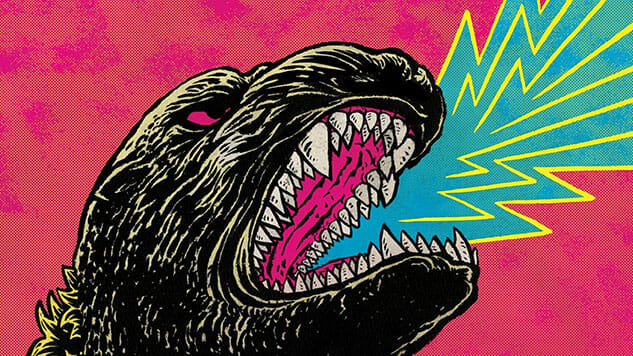Criterion’s Gorgeous Godzilla Box Set Is a Testament to Our Ability to Get Used to Anything
Dom reflects on Criterion's inestimably awesome 1,000th release.

In Ishiro Honda’s Ghidorah, the Three-Headed Monster (1964), one of our interchangeable human characters watches a game show in which two young boys can meet any celebrity they choose. The boys want to meet Mothra, a benevolent and giant larval moth kaiju revered by a small society of native islanders, introduced in Honda’s Mothra (1961) and again in Mothra vs. Godzilla, released earlier the same year as Ghidorah. Living up to their side of the bargain, the game show hosts call upon the assistance of the Peanuts—fairy-like tiny twin women whose choral songs wake Mothra from her hibernation—to sing for the monster’s presence at the studio. Mothra shows up, somehow. All of this is captured on prime time television.
Waving away the image of grinning pre-pubescents nervously approaching a gargantuan centipedal demigod, the aforementioned character scoffs, “Not my cup of tea.” A man witnesses miracles on his television, and gets bored. After four films set in Toho Studios’ Godzilla MonsterVerse—in which Eastern Asia must cope with the catastrophic likes of not only two previous Godzilla attacks, but the carnage associated with King Kong (Honda’s 1962 King Kong vs. Godzilla) and spiky-shelled Anguirus (introduced in the first Godzilla sequel, Motoyoshi Oda’s 1955 Godzilla Raids Again) making it to the Japanese mainland—Honda seems to think that people can get used to anything.
Go back to Godzilla, Ishiro Honda’s first film in the franchise from 1954, before the monster is even glimpsed off the shore of the island of Odo. A local fisherman tells reporter Hagiwara (Sachio Sakai) about the play they’re watching, describing it as the last remaining vestige of the ancient “exorcism” his people once practiced, sacrificing a young girl to the calamitous sea creature to satiate its hunger and cajole it into leaving some fish for the people to enjoy, at least until the next sacrifice. Honda’s smash hit—the first of its kind in Japan, the most expensive movie ever made in the country at the time, not even a decade after the atomic bombing of Hiroshima and Nagasaki—is, 30-something sequels over three times as many years, a surprisingly elegiac exorcism of its own. As J Hoberman describes in his essay for the film’s first Criterion release, much of Honda’s disaster imagery is “coded in naturalism,” a verite-like glimpse of the harrowing destruction wrought by the beast but indistinguishable from the aftermath of the Americans’ attacks in 1945, especially when the U.S. and Russia, among other powers, were still testing H-bombs in the Pacific in the early 1950s, bathing the Japanese in even more radiation than that in which they’d already been saturated.
And yet, Godzilla is a sci-fi flick, replete with a “mad” scientist in an eye patch and a human in a rubber dinosaur suit flipping over model bridges. That Honda handles such goofiness with an unrelentingly poetic hand, purging his nation’s psychological grief in broadly intimate volleys, is nothing short of astounding. Shots of Godzilla trudging through thick smoke, spotlights highlighting his gaping maw as the Japanese military’s weapons do nothing but shock the dark with beautiful chiaroscuro, have been rarely matched in films of its ilk (and in the director’s own legion of sequels); Honda saw gods and monsters and, with the world entering a new age of technological doom, found no difference between the two.
Ironic, perhaps, considering that Toho was such an influential studio during World War II, churning out heroic potboilers and adventure stories with overt through lines of imperialist propaganda. But Honda, who’d up to that point worked on post-war elegies with Akira Kurosawa and various war movie epics with special effects icon Eiji Tsuburaya (who’d go on to solidify the kaiju aesthetic of practical effects and small-scale city models), doesn’t seem to inveigh against the nationalism which dragged his country into a conflict that ultimately left them under foreign control, devastated by atomic weapons. Instead, he and co-writer Takeo Murata attempt a fantastical glimpse of a nation united by tragedy and used to trauma, abandoned by other countries to fight a giant monster—conjured, if not created, by the world-shaking weapons of all these outsiders—completely alone. The 15 Godzilla films released by Toho during the Showa Era (1926-1989) all similarly present the Japanese in a vacuum of self-determination: The fate of the world is on them, and only them, against an unending cosmos of Lovecraftian organisms, invading space aliens and vast ecological death.
In seemingly no time—though in reality almost a decade—the Godzilla franchise began to more explicitly target young audiences, especially care of Jun Fukuda’s lighter touch and zippier human drama, but the symbolism with which Honda first wrestled sustained. His King Kong vs. Godzilla transmogrified the tone of the first two Japanese Godzillas into technicolor popcorn entertainment, leaning a bit more into the B-movie expectations international audiences had saddled on the franchise while never abandoning Honda’s concerns about industrialization, how Japan’s emergence from its post-war slump coincided with a much more constant and undeniable environmental threat. Even as Godzilla gradually evolved into a force of good, a warrior for Mother Earth as Hollywood’s latest string of Godzilla movies establishes, the franchise never lost hold of the theme at its heart, the promise that human beings are the architects of our own destruction.
-

-

-

-

-

-

-

-

-

-

-

-

-

-

-

-

-

-

-

-

-

-

-

-

-

-

-

-

-

-

-

-

-

-

-

-

-

-

-

-








































